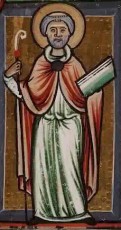Catholic Blesseds, Saints, Solemnities & Holy Days

Saint Bertin
Feast Day: September 5
Patronage: Converts
St. Bertin was born near Coutances, France. At an early age he entered the monastery of Luxeuil in France, where under the rule of St. Columbanus, he prepared himself for his future missionary career. In 638 he set out with two of his companions for the extreme northern part of France in order to assist his friend, Bishop St. Omer in evangelizing Morini.
This country as a vast marsh, overgrown with seaweed and brush. On one of these hills, Bertin and his companions built a small house where they went out daily to preach the word of God among the natives, most of who were still unaware of Christianity. Gradually, some converted, and joined the little band of missionaries and a larger monastery had to be built. A convert had donated a tract of land to Omer. Omer turned this whole tract over to the missionaries, who chose the spot for their new monastery. Eventually additional villages had grown up around the Monastery. Eventually the community grew so rapidly that in a short time this monastery also became too small, and another one was built where the city of St. Omer now stands.
The fame of Bertin’s learning and sanctity was so great that in a very short time more than 150 Monks lived under his rule, among them was St. Winnoc. When nearly all the neighborhood was converted to Christianity, the marshy land transformed into a fertile plain. Bertin, knowing that his death was not far off, appointed Rigobert, a pious monk as his successor, while he himself spent the remainder of his life preparing for a happy death. He died shortly after in 709, and was venerated as a saint soon after his death.
Shortly after his death, the abbey received the name of St. Bertin. In medieval times the Abbey of St. Bertin was famous as a center of sanctity and learning. The Abbey Church, now in ruins, was one of the finest fourteenth century gothic edifices, very elaborate. In later times, it’s library, archives, and art-treasures were renowned both in and out of France. The monks were expelled in 1791, and in 1799 they Abbey and its church were sold at auction.





